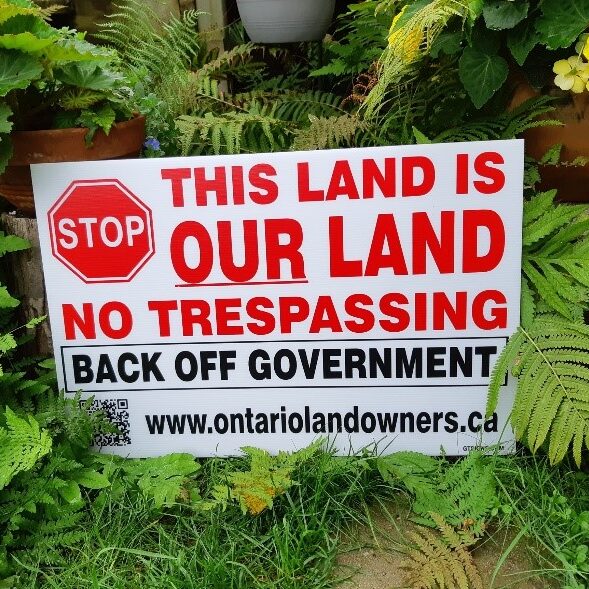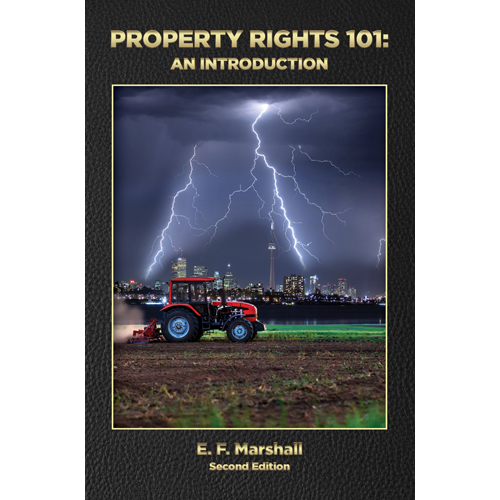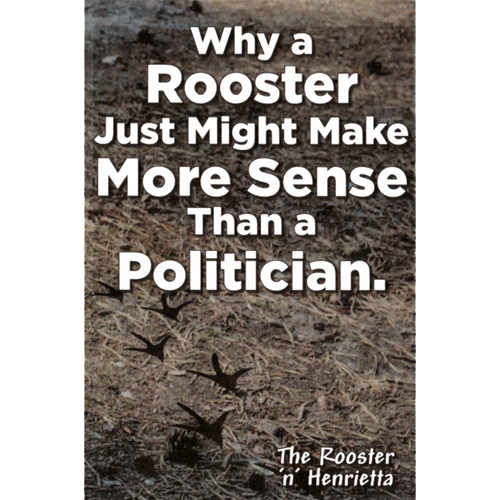Fighting Back – Stand up for your Private Property – No one else will by Jack Winkler
- 2018-08-01
- By admin
- Posted in Latest News
This article first appeared in the Landowner Magazine in the April/May 2013 edition. We thought it was worth republishing especially as municipalities are inventing new ways to control our private property with designations such as Natural Heritage Systems.
I am a Registered Professional Forester who helps landowners across the southern part of Ontario manage their woodlots. As part of my responsibility, I need to determine what can be legally done in or to these woodlots.
I heard Liz Marshall of the Ontario Landowners Association speak on the subject of Crown Patents and it sounded like landowners have far more say in the fate of their trees than what we are given to believe. Being suspicious of this, I spent considerable time researching Supreme Court of Canada and Ontario Superior Court of Justice Crown Patent-related judgments on their respective websites.
Concerning trees and woods, it turns out that at least two recent judgments by the Ontario Superior Court of Justice involving two specific Crown Patents support Ms. Marshall’s claim that landowners do have more authority over their land and water than they think they do.
Many Crown Patents contain the phrase “Together with all the woods and water”. For example, original Canada Company Patents cover almost 2.5 million acres and they contain that phrase.
This phrase is known as an “express grant” as it is particular and not general in nature.
The Ontario Supreme Court of Justice judgment for Saker v. Middlesex Centre (Chief Building Official) – 2001 CanLII 28088, concerning navigable waters was later supported as an argument in Simpson v. Ontario (MNR) – 2011 onsc 1168.
Both rulings were based on the original wordings and intents of the respective Crown Patents.
Both lumped woods and waters together in their findings.
In the Saker case, Paragraphs [15] and [16], the Judge considered the included grant of woods and water to be an “express grant” that did pass to the original patentee from the Crown in fee simple. That means that the woods with any original reservation, limitation or condition expressed in that grant do pass from owner to owner forever.
The Judge in the Simpson case, paragraphs [61] and [62], agreed with the Saker Judge in his section called “Express Grant”.
Carry this forward to the January 2013 Forest Conservation Bylaw templates that I found on the Ontario Woodlot Association website. https://www.ontariowoodlot.com/forest-management/legislation/developing-forest-conservation-by-laws
Now we have a group of foresters and Bylaw enforcement officers saying in Section ” 3: Exemptions”, Page 8, of both of their suggested bylaw templates, that for exemptions from a Bylaw, “This would include Trees on private land that the Province has retained timber rights to.”
The Province retained such timber rights through reservations that were expressed in some original Crown Patents. In 1990, The Province voluntarily voided its reservation of trees in Crown Patents that were issued prior to April 01, 1869. Reservations remain in effect on later Crown Patents.
This group of regulatory foresters of authority recognizes Crown Patents and their terms.
I have copies of Crown Patents that cover about 440,000 acres in total. Almost all of these Patents contain the “Together with all the woods and water” phrase. My copies include more than 200,000 acres in Huron and Perth Counties. The original Crown Patent for my property within the boundaries of London covers 200 acres and it contains that phrase.
Therefore, it stands to reason that a tree cutting bylaw would have no effect against such a Crown Patent. Since I could find no case that specifically dealt with the express grant of woods on its own, I expect arguments will still be made that a Court must still verify these particular land rights on its own merit.
In the meantime, I suggest that landowners consider hiring a forestry consultant that appears to have a like mind as yours, and insist that your wishes are recognized by both the consultant and your municipality.
If you want to personally manage your own woodlot, Provincial law does allow you to personally design, specify and approve a silvicultural prescription with its accompanying treatments, including timber harvesting, without involving a consultant.
Search:
Categories
Archives
- April 2024
- January 2024
- December 2023
- November 2023
- August 2023
- July 2023
- June 2023
- May 2023
- April 2023
- March 2023
- February 2023
- January 2023
- December 2022
- November 2022
- October 2022
- September 2022
- August 2022
- July 2022
- June 2022
- May 2022
- April 2022
- March 2022
- February 2022
- January 2022
- December 2021
- November 2021
- October 2021
- September 2021
- August 2021
- July 2021
- June 2021
- May 2021
- April 2021
- March 2021
- February 2021
- January 2021
- December 2020
- November 2020
- October 2020
- September 2020
- August 2020
- July 2020
- June 2020
- May 2020
- April 2020
- March 2020
- February 2020
- January 2020
- December 2019
- November 2019
- October 2019
- September 2019
- August 2019
- July 2019
- June 2019
- May 2019
- April 2019
- March 2019
- February 2019
- January 2019
- December 2018
- November 2018
- October 2018
- September 2018
- August 2018
- July 2018
- June 2018
- May 2018
- April 2018
- March 2018
- February 2018
- January 2018
- December 2017
- November 2017
- October 2017
- September 2017
- August 2017
- July 2017
- June 2017
- May 2017
- April 2017
- March 2017
- February 2017
- January 2017
- December 2016
- November 2016
- October 2016
- September 2016
- August 2016
- July 2016
- June 2016
- May 2016
- April 2016
- March 2016
- February 2016
- January 2016
- December 2015
- November 2015
- October 2015
- September 2015
- August 2015
- July 2015
- June 2015
- May 2015
- April 2015
- March 2015
- February 2015
- January 2015
- December 2014
- November 2014
- October 2014
- September 2014
- August 2014
- July 2014
- June 2014
- May 2014
- April 2014
- March 2014
- February 2014
- January 2014
- December 2013
- November 2013
- October 2013
- September 2013
- August 2013
- June 2013
- April 2013
- October 2012
- May 2012
- September 2011



